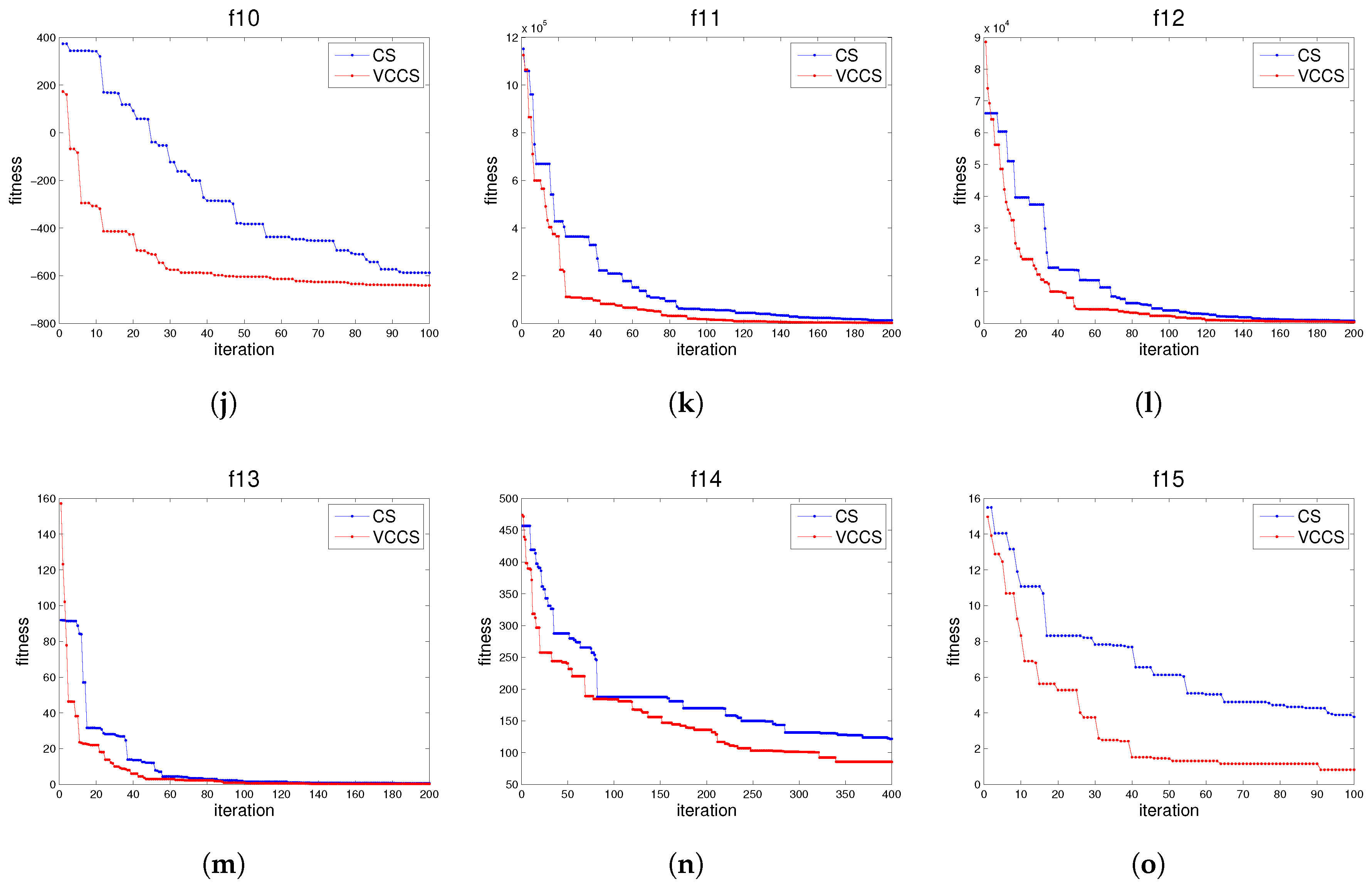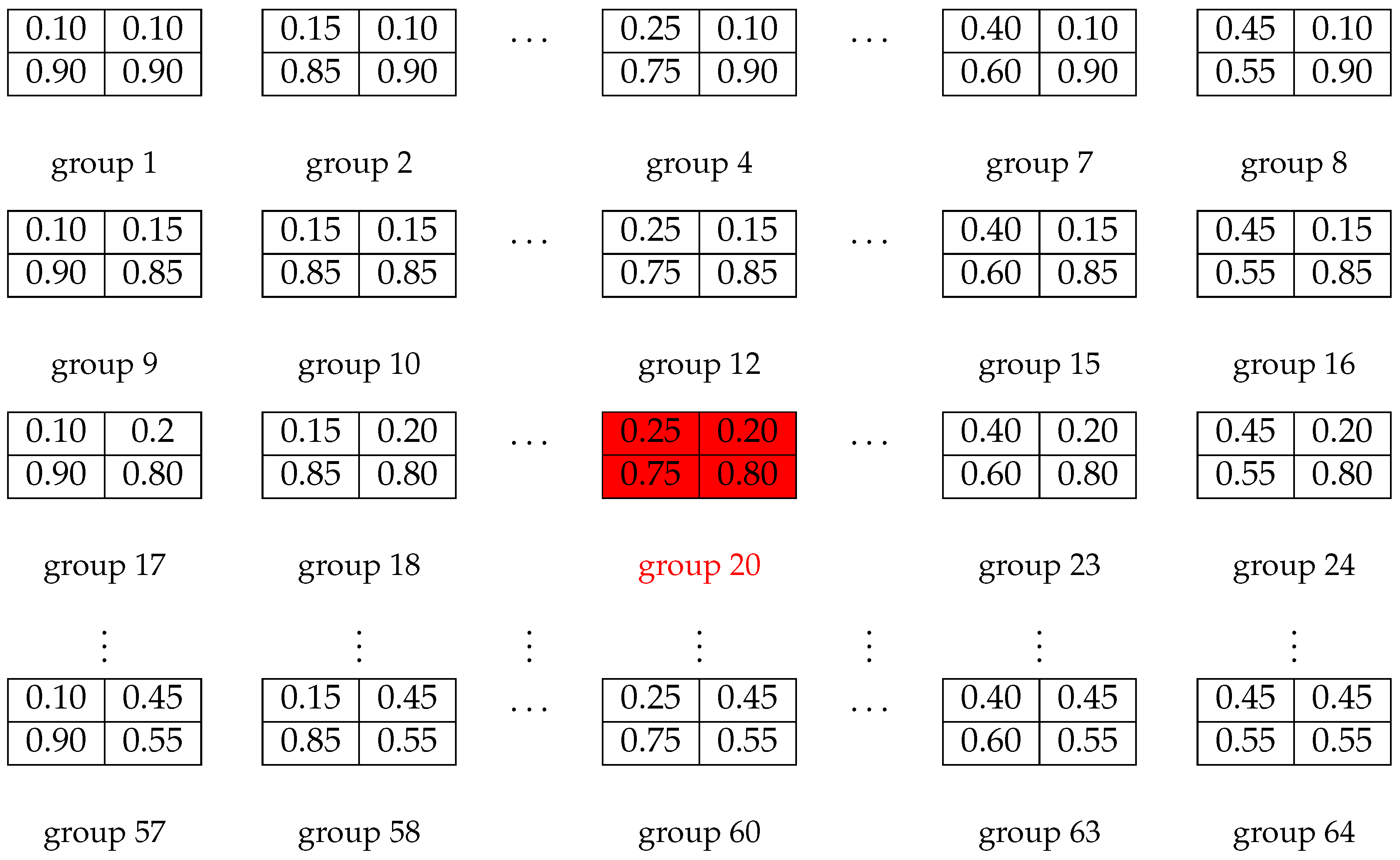Modified Cuckoo Search Algorithm with Variational Parameters and Logistic Map
Abstract
:1. Introduction
2. Preliminary
2.1. Cuckoo Search Algorithm
| Algorithm 1: Cuckoo Search via Lévy Flights |
 |
2.2. The Disadvantages of the Cuckoo Search Algorithm
- InitializationCuckoo search algorithm uses the random number to initiate these location of nests. Sometimes, the location of these nests will be the same, and sometimes the location of these nests are not properly dispersed in a defined area. Therefore, it causes repeated calculations and the easy chance to fall into local optimal solution [24].
- Parameters andIn most cases, Yang and Deb used or , where L is the characteristic scale of the problem of interest [29]. Yang and Deb also suggested = 0.25 [18]. In other words, and are fixed number. The properties of the two parameters are the shortcomings of the algorithm, because and should be changed with the progress of iterator, when CS algorithm search a local optimal solution and the global optimal solution.
- Boundary issueCS algorithm uses Lévy flights and random walk to find nest location [18,30]. The locations of some nests may be out of the boundary; when this happens CS algorithm uses the boundary value to replace these location. The bound dealing method will result in a lot of nests at the same location on the boundary, which is inefficient.
3. Modified Cuckoo Search Algorithm: VLCS
3.1. Nest Location of Each Host Are Initialized by Logistic Map of Each Dimension
| Algorithm 2: Nest location of each host is initialized by logistic map of each dimension |
 |
3.2. Step Size and Are Changed by Coefficient Function
3.3. Boundary Is Constrained by Logistic Map of Each Dimension
| Algorithm 3: Boundary is constrained by logistic map of each dimension |
 |
3.4. Proposed VLCS algorithm
| Algorithm 4: VLCS algorithm |
 |
4. Simulation Experiments
5. Conclusions
Acknowledgments
Author Contributions
Conflicts of Interest
References
- Shubin, G.R. Optimization Problem Formulation for Multidisciplinary Design. Siam J. Optim. 1993, 4, 754–776. [Google Scholar]
- Ponsich, A.; Jaimes, A.L.; Coello, C.A.C. A Survey on Multiobjective Evolutionary Algorithms for the Solution of the Portfolio Optimization Problem and Other Finance and Economics Applications. IEEE Trans. Evolut. Comput. 2013, 17, 321–344. [Google Scholar] [CrossRef]
- Gaobo, Y.; Xingming, S.; Xiaojing, W. A Genetic Algorithm based Video Watermarking in the DWT Domain. In Proceedings of the International Conference on Computational Intelligence and Security, Guangzhou, China, 3–6 November 2006; pp. 1209–1212. [Google Scholar]
- Tao, C.; Zhang, Y.; Jiang, J.J. Estimating system parameters from chaotic time series with synchronization optimized by a genetic algorithm. Phys. Rev. E Stat. Nonlinear Soft Matter Phys. 2007, 76, 016209. [Google Scholar] [CrossRef] [PubMed]
- Szpiro, G.G. Forecasting chaotic time series with genetic algorithms. Phys. Rev. E Stat. Phys. Plasmas Fluids Relat. Interdiscip. Top. 1997, 55, 2557–2568. [Google Scholar] [CrossRef]
- Chou, Y.H.; Kuo, S.Y.; Chen, C.Y.; Chao, H.C. A Rule-Based Dynamic Decision-Making Stock Trading System Based on Quantum-Inspired Tabu Search Algorithm. IEEE Access 2014, 2, 883–896. [Google Scholar] [CrossRef]
- Wei, K.C.; Sun, X.; Chu, H.; Wu, C.C. Reconstructing permutation table to improve the Tabu Search for the PFSP on GPU. J. Supercomput. 2017, 73, 4711–4738. [Google Scholar] [CrossRef]
- Alidaee, B.; Ramalingam, V.P.; Wang, H.; Kethley, B. Computational experiment of critical event tabu search for the general integer multidimensional knapsack problem. Ann. Oper. Res. 2017, 1–17. [Google Scholar] [CrossRef]
- Bandyopadhyay, S.; Saha, S.; Maulik, U.; Deb, K. A Simulated Annealing-Based Multiobjective Optimization Algorithm: AMOSA. IEEE Trans. Evolut. Comput. 2008, 12, 269–283. [Google Scholar] [CrossRef]
- Mamano, N.; Hayes, W.B. SANA: Simulated annealing far outperforms many other search algorithms for biological network alignment. Bioinformatics 2017, 33, 2156–2164. [Google Scholar] [CrossRef] [PubMed]
- Angland, P.; Haberberger, D.; Ivancic, S.T.; Froula, D.H. Angular filter refractometry analysis using simulated annealing. Rev. Sci. Instrum. 2017, 88, 103510. [Google Scholar] [CrossRef] [PubMed]
- Fei, G. Parameter estimation for chaotic system based on particle swarm optimization. Acta Phys. Sin. 2006, 55, 577–582. [Google Scholar]
- Garcia-Nieto, J.; Olivera, A.C.; Alba, E. Optimal Cycle Program of Traffic Lights With Particle Swarm Optimization. IEEE Trans. Evolut. Comput. 2013, 17, 823–839. [Google Scholar] [CrossRef]
- Salahi, M.; Jamalian, A.; Taati, A. Global minimization of multi-funnel functions using particle swarm optimization. Neural Comput. Appl. 2013, 23, 2101–2106. [Google Scholar] [CrossRef]
- Martens, D.; Backer, M.D.; Haesen, R.; Vanthienen, J.; Snoeck, M.; Baesens, B. Classification with Ant Colony Optimization. IEEE Trans. Evolut. Comput. 2007, 11, 651–665. [Google Scholar] [CrossRef]
- Yang, Q.; Chen, W.N.; Yu, Z.; Gu, T.; Li, Y.; Zhang, H.; Zhang, J. Adaptive Multimodal Continuous Ant Colony Optimization. IEEE Trans. Evolut. Comput. 2017, 21, 191–205. [Google Scholar] [CrossRef]
- Ye, K.; Zhang, C.; Ning, J.; Liu, X. Ant-colony algorithm with a strengthened negative-feedback mechanism for constraint-satisfaction problems. Inf. Sci. 2017, 406–407, 29–41. [Google Scholar] [CrossRef]
- Yang, X.S.; Deb, S. Cuckoo Search via Lévy Flights. In Proceedings of the World Congress on Nature & Biologically Inspired Computing, 2009 (NaBIC 2009), Coimbatore, India, 9–11 December 2010; pp. 210–214. [Google Scholar]
- Shair, E.F.; Shen, Y.K.; Abdullah, A.R.; Jaafar, H.I.; Saharuddin, N.Z.; Abidin, A.F.Z. Cuckoo Search Approach for Cutting Stock Problem. Int. J. Inf. Electron. Eng. 2015, 5, 138–143. [Google Scholar] [CrossRef]
- Medjahed, S.A.; Saadi, T.A.; Benyettou, A.; Ouali, M. Binary cuckoo search algorithm for band selection in hyperspectral image classification. IAENG Int. J. Comput. Sci. 2015, 42, 1–9. [Google Scholar]
- Walton, S.; Hassan, O.; Morgan, K.; Brown, M.R. Modified cuckoo search: A new gradient free optimisation algorithm. Chaos Solitons Fractals 2011, 44, 710–718. [Google Scholar] [CrossRef]
- Li, X.; Yin, M. Modified cuckoo search algorithm with self adaptive parameter method. Inf. Sci. 2015, 298, 80–97. [Google Scholar] [CrossRef]
- Wang, G.G.; Deb, S.; Gandomi, A.H.; Zhang, Z.; Alavi, A.H. A Novel Cuckoo Search with Chaos Theory and Elitism Scheme. In Proceedings of the International Conference on Soft Computing and Machine Intelligence, New Delhi, India, 26–27 September 2015; pp. 64–69. [Google Scholar]
- Huang, L.; Ding, S.; Yu, S.; Wang, J.; Lu, K. Chaos-enhanced Cuckoo search optimization algorithms for global optimization. Appl. Math. Model. 2016, 40, 3860–3875. [Google Scholar] [CrossRef]
- Liu, X.; Fu, M. Cuckoo search algorithm based on frog leaping local search and chaos theory. Appl. Math. Comput. 2015, 266, 1083–1092. [Google Scholar] [CrossRef]
- Zheng, H.; Zhou, Y. A novel Cuckoo Search optimization algorithm base on gauss distribution. J. Comput. Inf. Syst. 2012, 8, 4193–4200. [Google Scholar]
- Li, M.; Cao, D. Hybrid optimization algorithm of Cuckoo Search and DE. Comput. Eng. Appl. 2013, 49, 57–60. [Google Scholar]
- Chiroma, H.; Herawan, T.; Fister, I., Jr.; Fister, I.; Abdulkareem, S.; Shuib, L.; Hamza, M.F.; Saadi, Y.; Abubakar, A. Bio-Inspired Computation: Recent Development on the Modifications of the Cuckoo Search Algorithm. Appl. Soft Comput. 2017, 61, 149–173. [Google Scholar] [CrossRef]
- Yang, X.S.; Deb, S. Cuckoo search: Recent advances and applications. Neural Comput. Appl. 2014, 24, 169–174. [Google Scholar] [CrossRef]
- Sharma, A.; Singh, R.; Liaw, P.K.; Balasubramanian, G. Cuckoo searching optimal composition of multicomponent alloys by molecular simulations. Scr. Mater. 2017, 130, 292–296. [Google Scholar] [CrossRef]
- Kocarev, L.; Jakimoski, G. Logistic map as a block encryption algorithm. Phys. Lett. A 2001, 289, 199–206. [Google Scholar] [CrossRef]
- Wu, G.C.; Baleanu, D. Discrete fractional logistic map and its chaos. Nonlinear Dyn. 2013, 75, 283–287. [Google Scholar] [CrossRef]
- Jia, B.; Yu, B.; Wu, Q.; Wei, C.; Law, R. Adaptive affinity propagation method based on improved cuckoo search. Knowl.-Based Syst. 2016, 111, 27–35. [Google Scholar] [CrossRef]
- Chattopadhyay, R. A study of test functions for optimization algorithms. J. Optim. Theory Appl. 1971, 8, 231–236. [Google Scholar] [CrossRef]
- Shang, Y.W.; Qiu, Y.H. A Note on the Extended Rosenbrock Function. Evolut. Comput. 2006, 14, 119–126. [Google Scholar] [CrossRef] [PubMed]
- Schoen, F. A wide class of test functions for global optimization. J. Glob. Optim. 1993, 3, 133–137. [Google Scholar] [CrossRef]




| Test Function | Dimension | Range | Optimum |
|---|---|---|---|
| 15 | 0 | ||
| 2 | −1 | ||
| 15 | 0 | ||
| 2 | −186.7309 | ||
| 15 | 0 | ||
| 15 | 0 | ||
| 16 | 0 | ||
| 10 | −4189.829 | ||
| 10 | 0 | ||
| 5 | −4.6877 | ||
| 20 | −654.6 | ||
| 30 | 0 | ||
| 30 | 0 | ||
| 30 | 0 | ||
| 30 | 0 | ||
| 2 | 0.398 |
© 2018 by the authors. Licensee MDPI, Basel, Switzerland. This article is an open access article distributed under the terms and conditions of the Creative Commons Attribution (CC BY) license (http://creativecommons.org/licenses/by/4.0/).
Share and Cite
Liu, L.; Liu, X.; Wang, N.; Zou, P. Modified Cuckoo Search Algorithm with Variational Parameters and Logistic Map. Algorithms 2018, 11, 30. https://doi.org/10.3390/a11030030
Liu L, Liu X, Wang N, Zou P. Modified Cuckoo Search Algorithm with Variational Parameters and Logistic Map. Algorithms. 2018; 11(3):30. https://doi.org/10.3390/a11030030
Chicago/Turabian StyleLiu, Liping, Xiaobo Liu, Ning Wang, and Peijun Zou. 2018. "Modified Cuckoo Search Algorithm with Variational Parameters and Logistic Map" Algorithms 11, no. 3: 30. https://doi.org/10.3390/a11030030





